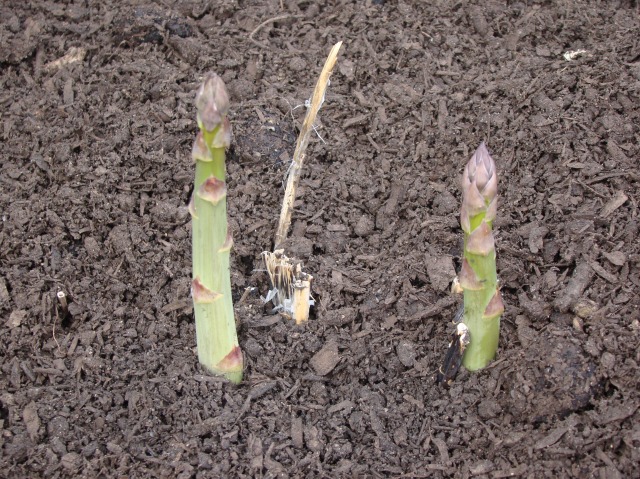Today I enjoyed the first rooftop asparagus of the season, which of course raised the knotty question of Manhattan rooftop terroir.
Let’s start with the question of what terroir is: the unique, organoleptic qualities associated with food and drink from a specific place, reflecting that place’s distinctive blend of mineralization, soil chemistry, moisture, temperature, altitude, slope, and light. Or, for the geneticists out there, think epigenetics: the genes of two plants may be the same, but their expression differs depending on the environment in which the plant is grown. More recently, writers such as Rowan Jacobsen (American Terroir) and Robin Shulman (Eat the City) have advanced a concept of cultural terroir, encompassing regionalism and tradition or, as Jacobson puts it, “a partnership between person, plant, and environment to bring something unique into the world.”
Asparagus, you might be thinking, are not like wine, oysters, or other foods we most associate with distinctive terroir; don’t they taste pretty much the same wherever they are grown? Mais non. The great French chef Yannick Alleno is definitive: the same breed of asparagus grown in Vallauris, near Cannes, will taste differently if grown in California: “This,” he argues, “is where terroir expresses itself.” And in large part due to his influence, the French have embraced the concept of urban terroir, epitomized by Chef Alleno’s fine restaurant, Terroir Parisien, which features artichokes from Paris, asparagus from Argenteuil and cabbage from Pontoise (both northwest suburbs), and peaches from Montreuil (only 6 km from the center of town). So if there is a terroir Parisien, mustn’t there be a Manhattan terroir? And a terroir expressed by growing food 35 floors above The Battery?
The first objection to the idea of rooftop terroir would doubtless be that the green roof is a wholly artificial environment, without any “natural” or indigenous soil conditions. But this objection does not withstand scrutiny. Many of the most celebrated ground-level terroirs result from centuries or even millennia of human manipulation. Moreover, although a green roof has no invariable soil condition, it certainly is completely distinctive in its combination of other physical characteristics (moisture, temperature, altitude, slope, and light) and as an expression of the culture of the place and the practices of the farmer. So, bien sur, each rooftop garden has a distinctive terroir. And the whole notion of urban rooftop terroir must be counted among the great unexploited potentials of urban agriculture: we have yet to discover which plants respond to the conditions of urban life and green roof cultivation with an expression of flavor that is especially interesting or desirable.
And my rooftop asparagus? How did it express terroir? I honestly cannot say. The answer requires disciplined comparison of my rooftop spears with others of the same variety grown elsewhere. An experiment for another day. But in the mean time, my first spear of the season tasted clean, bright, moist, with just the right amount of gentle crunch, and a mild green flavor enhanced by an undertone of earthiness. Happy spring to all.



Ahhhhh….tender, meaty, crisp, crunchy asparagus fresh from your (my) own garden. Is there any other taste in the world like it? Regardless of the tenoir! Looking forward to July, even without asparagus. Cheers, Julie
I agree about urban rooftop gardens being a terroir! I think the “terroir Manhattan” will be very much like Manhattan itself with a distinct character in each neighborhood. It’s so important that culture is expressed through the the production and preparation of food and not lost in the flood of bland, chain restaurants.
Hi, I’ve just found your site and I’m intrigued. Growing 35 stories high do you get many insects/birds visit your garden?
Thanks for visiting. I have plenty of pollinators, which of course is necessary for the fruit trees and veggies. The key is providing a sufficiently diverse habitat of other trees, shrubs and perennials. In 2012, after only two years of growing, we did a study and found, among other things, 23 species of wild bees living on the roof. I have been told, but am not sure this is authoritative, that inserts can climb 11 stories vertically, but then need a green place to rest. So as long as there is a balcony or flower pot along the way, they can easily reach the 35th floor. This was certainly my experience. After the initial planting, cricket, bees and a variety to other insects arrived almost immediately.